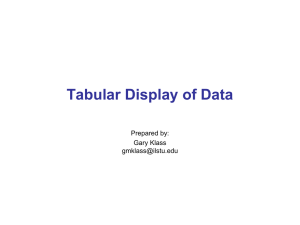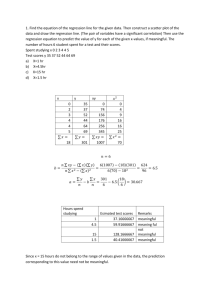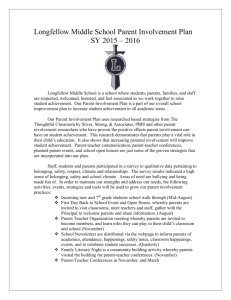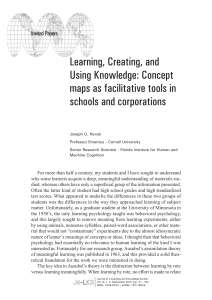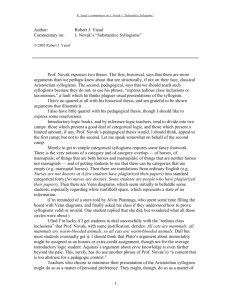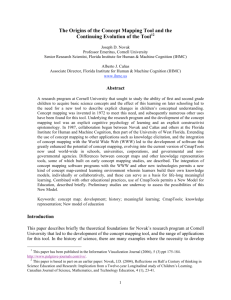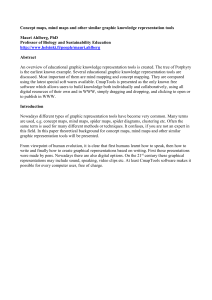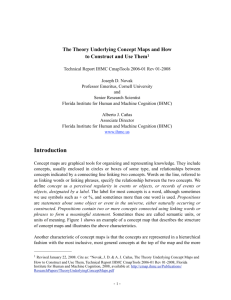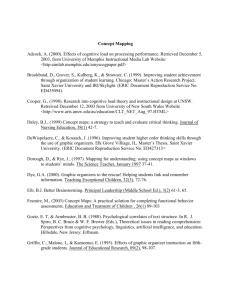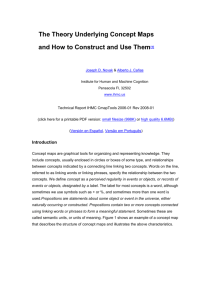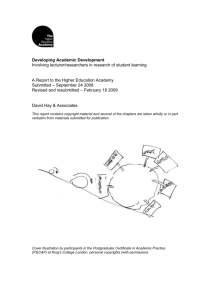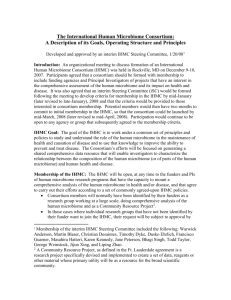MLMerrill Third Grade Student Experience with Concept Maps
advertisement
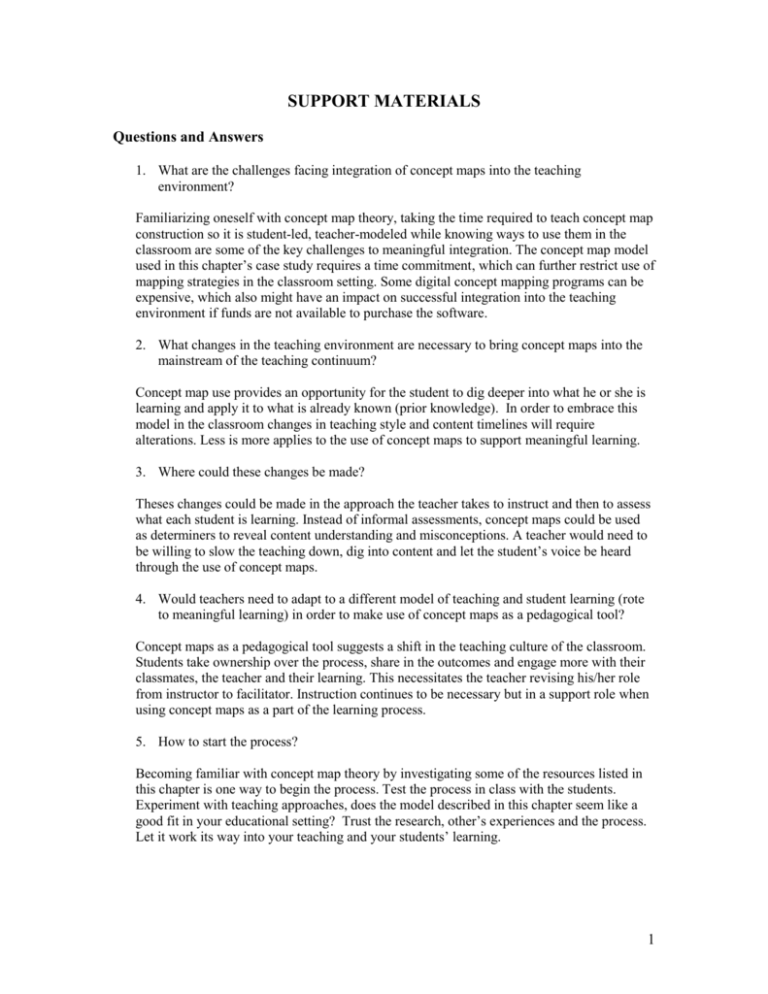
SUPPORT MATERIALS Questions and Answers 1. What are the challenges facing integration of concept maps into the teaching environment? Familiarizing oneself with concept map theory, taking the time required to teach concept map construction so it is student-led, teacher-modeled while knowing ways to use them in the classroom are some of the key challenges to meaningful integration. The concept map model used in this chapter’s case study requires a time commitment, which can further restrict use of mapping strategies in the classroom setting. Some digital concept mapping programs can be expensive, which also might have an impact on successful integration into the teaching environment if funds are not available to purchase the software. 2. What changes in the teaching environment are necessary to bring concept maps into the mainstream of the teaching continuum? Concept map use provides an opportunity for the student to dig deeper into what he or she is learning and apply it to what is already known (prior knowledge). In order to embrace this model in the classroom changes in teaching style and content timelines will require alterations. Less is more applies to the use of concept maps to support meaningful learning. 3. Where could these changes be made? Theses changes could be made in the approach the teacher takes to instruct and then to assess what each student is learning. Instead of informal assessments, concept maps could be used as determiners to reveal content understanding and misconceptions. A teacher would need to be willing to slow the teaching down, dig into content and let the student’s voice be heard through the use of concept maps. 4. Would teachers need to adapt to a different model of teaching and student learning (rote to meaningful learning) in order to make use of concept maps as a pedagogical tool? Concept maps as a pedagogical tool suggests a shift in the teaching culture of the classroom. Students take ownership over the process, share in the outcomes and engage more with their classmates, the teacher and their learning. This necessitates the teacher revising his/her role from instructor to facilitator. Instruction continues to be necessary but in a support role when using concept maps as a part of the learning process. 5. How to start the process? Becoming familiar with concept map theory by investigating some of the resources listed in this chapter is one way to begin the process. Test the process in class with the students. Experiment with teaching approaches, does the model described in this chapter seem like a good fit in your educational setting? Trust the research, other’s experiences and the process. Let it work its way into your teaching and your students’ learning. 1 Epilogue The case study described in this chapter has shined a small albeit a bright light, on the importance and applicability of concept maps at the elementary level to support the learning of science. The benefits of this teaching approach were apparent as students responded enthusiastically and with strong motivation to the inclusion of concept maps in their studies. Motivation plays an important part in the learning environment. When students are motivated to achieve a goal, their investment in the learning activities reflects that energy. Concept maps added to the element of motivation throughout the watershed study. The integration of student-constructed concept maps in science class over time supports and enhances the process whereby students self-reflect on their own knowledge organization while providing the teacher with a pedagogical tool displaying student misconceptions within the content and structure of each student’s concept map. A watershed as a system comprised of many distinct (visible to the students) and non-distinct (not immediately apparent to the students) parts that are interconnected and interdependent with each other was a concept third grade students in this study had not previously encountered, as the science curriculum K – 2 embraced different topics and focus. Taking the students to a place of understanding whereby they could envision how so many individual parts could add up to a system was a long process. It was not until the class undertook to construct 3-D models of their local watershed system that the concept of one system made up of many parts, such as lakes, streams, ponds, bogs, and other elements of the water cycle, could be simultaneously seen and understood as one thing, and as many things. Long-range effects of this case study would suggest more research is needed on concept maps in other educational settings, as well as exploring its use in other grades. Additionally, further research with different populations of learners from the early years to post-secondary warrant investigation as well as. Also ways of using concept maps should be examined. This case study has provided an example of alternative assessment protocols in science education at the elementary level whereby misconceptions are revealed and where the learner is actively engaged the construction of personal knowledge. This case study demonstrates benefits of concept mapping to support student learning and ways to implement concept maps into the teaching of science at the elementary level. 2 Lessons Learned 1. Redefining the Concept Map Evaluative Rubric for greater sensitivity to concept map changes, including color-coding and the use of embedded or nested notes. The CMER as it was designed for use in this case study caught a range of information on each concept map. However, as each map was evaluated and discussed among the raters and during student interviews, it became apparent that so much more was included in each map that was not showing up on the CMER. 2. Teachers need support through professional development to find ways to integrate concept maps into their teaching programs and to understand the connection between concept maps and meaningful learning. Professional development workshops can explain the benefits of concept maps in ways accessible to those in the field of education. Through professional development opportunities, the gap between concept map theory and meaningful ways to use concept maps can be bridged. 3. Concept map use as a teaching and assessment strategy can flourish in educational settings if all stakeholders are brought on board. If all stakeholders have a voice in the process whereby different models for teaching and assessment are introduced, then implementation of a new teaching or assessment protocol within the educational community will have a better chance of succeeding rather than if change occurs in isolation. To have an opportunity to speak out about concerns and share questions is key to the process of transition and change in the classrooms of our educational institutions. 3 List of Resources for Further Study Institute for Human and Machine Cognition - http://www.ihmc.us/ www. Merrilleducationalconsultant.com COSEE – OS - http://cosee.umaine.edu/ Inspiration® - http://www.inspiration.com/ Inspiration® Maps™ - https://itunes.apple.com/us/app/inspiration-maps/id510173686 Ausubel, D. P. (2000). The acquisition and retention of knowledge. Dordrecht: Kluwer Hay, D., Kinchin, I., & Lygo-Baker, S. (2008) Making learning visible: The role of concept mapping in higher education. Studies in Higher Education, 33, 295-311. Kinchin, I. M. (2000) Using concept maps to reveal understanding: A two-tier analysis. School Science Review, 81, 41-46. Novak, J. D. (1990). Concept mapping: A useful tool for science education. Journal of Research in Science Teaching, 27, 937-49. Novak, J. D. (2010). Learning, creating and using knowledge: Concept maps as facilitative tools in schools and corporations. New York: Routledge Novak, J. D. & Cañas, A. J. (2006). The theory underlying concept maps and how to construct them (Technical Report IHMC CmapTools 2006-01 Rev 01-2008) Florida Institute for Human and Machine Cognition. 4
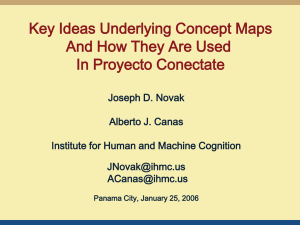

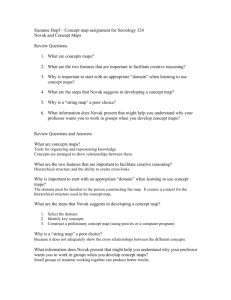
![[[1]] *1 Darjeeling April 2nd " I wish you could see my splendid](http://s3.studylib.net/store/data/009042775_1-f0de172502679c0eed7248a3b32b232e-300x300.png)



